Episodes

Wednesday Oct 12, 2022
Wednesday Oct 12, 2022
This week, we have the privilege of interviewing Hank Poore, an AAC user and Tobi Dynavox ambassador who has his own foundation, hankpoorefoundation.org. Hank shares about becoming a proficient AAC communicator, the AAC journey Hank took to come to his current eye gaze system, advice for looking for a job as an AAC user, work Hank does with his foundation, and more!
Before the interview, Rachel and Chris discuss a breakthrough that Rachel had with one of her coaching clients. Her client’s Mom and Dad have been sending in videos of them working with their child, after which they watch the videos with Rachel and talk through how they can become more effective communication partners. Recently, when watching a video of a session, they noticed how anxious the AAC user was getting when asked a question that he doesn’t know the answer to. The family discussed with Rachel how they can switch from questions that have a “right” and “wrong” answer to questions that are more open ended to help their child feel less anxiety when asked a question. The family would never have noticed if it wasn’t recorded, so in this case, video was an excellent resource.
Key ideas this week:
🔑 There is evidence to suggest that people with disabilities are asked more questions than people without disabilities - make sure that you are not turning a communication exchange into an interrogation.
🔑 When we are selecting an AAC device for a user, sometimes we can get caught up in picking the one “best” tool. We shouldn’t focus exclusively on selecting the one tool or the primary tool that they will use - in some cases, like Hank’s, it may be that a combination of tools will be successful for a user.
🔑 Technology is changing and growing at such a fast rate, in some cases a tool that didn’t work years ago may have been improved. For Hank, he tried eye gaze years ago, but it was too difficult to use. However, when he tried it again more recently, the technology had improved and it was much more effective for him.
Visit talkingwithtech.org to access previous episodes, resources, and CEU credits that you can earn for listening to TWT episodes!
Help us develop new content and keep the podcast going strong! Support our podcast at patreon.com/talkingwithtech!
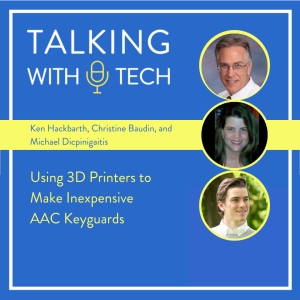
Thursday Oct 06, 2022
Thursday Oct 06, 2022
This week, Chris interviews Ken Hackbarth, Christine Baudin, and Micheal Dicpinigaitis about 3D printing custom items related to assistive technology, including keyguards! Ken, Christine, and Michael share about discuss Ken’s website volksswitch.org, which has resources for how to create files for 3D printers that tell it to build a keyguard that fits an iPad with AAC apps perfectly.
Before the interview, Rachel and Chris talk about environmental core boards (e.g. “playground boards”) and some considerations to make before you install one, including making sure that the board is at the correct height for the students who will be using it.
Key ideas this week:
🔑 Keyguards are applicable in many instances where you wouldn’t initially recommend them. They can help individuals with moderate motor control take advantage of larger language sets by helping them effectively select smaller buttons on an AAC device. Volksswitch provides free, ready-to-print keyguard designs for a collection of popular AAC apps and popular iPad cases!
🔑 One great thing about volksswitch.org is that they provide an app that lets you customize your keyguard based on several common combinations of iPads, cases, and the most common AAC apps (e.g. LAMP WFL, Proloquo2go, TouchChat). This allows someone with limited coding and engineering experience to create and print a keyguard effectively.
🔑 Michael sells 3D printed keyguards on his Etsy website, https://www.etsy.com/shop/AdaptedCreations. In addition to selling keyguards, he also sells cases that match the keyguards, switch adapted toys, and switch mounts.
🔑 One reason that keyguards were an obvious choice for 3D printing is the high cost of getting a keyguard professionally laser cut (approximately $80-$150). As as long as you have access to a 3D printer, you can make many keyguards for the price of one laser-cut keyguard.
Help us develop new content and keep the podcast going strong! Support our podcast at patreon.com/talkingwithtech!
To listen to this episode, search "Talking with Tech" in your podcast player of choice or go to www.talkingwithtech.org/episodes/print-keyguards
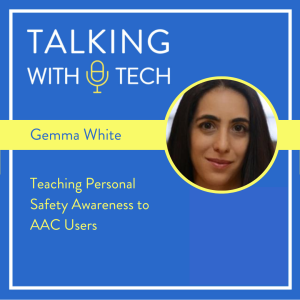
Wednesday Sep 28, 2022
Wednesday Sep 28, 2022
This week, Rachel invites Gemma White back to TWT to talk about personal safety awareness and self advocacy for AAC users. Gemma recently gave a presentation at AAC in the Cloud, “Where is the Penis?: Equipping AAC Users to Discuss Personal Safety Awareness with Personal Safety Curriculum”. Gemma talks about this presentation, why words like “penis” and “vagina” should be in AAC users devices, ways that we can collaborate to support personal safety awareness, and other ways that we can empower AAC users to protect themselves from neglect and abuse.
Before the interview, Rachel and Chris discuss some comments made by an SLP who works with one of Rachel’s clients and focuses only on verbal speech. This client has Childhood Apraxia of Speech and is highly unintelligible. He has been making good progress with his AAC and is now choosing to use it more often. Recently, the other SLP commented that “AAC is holding back verbal speech” because the client chose to use his AAC more than verbal speech to communicate. Rachel shares how she responded, the reasons why the other SLP may have believed this, and why following the student’s lead is so important when accepting communication modalities.
Key ideas this week:
🔑 If your school or practice has a curriculum developed to teach children about personal safety awareness, then you can collaborate with the whole team to add language to AAC user’s devices that support what they’re learning about their bodies and safety.
🔑 A person’s gender does not always match the body parts they were born with - It’s important to separate words related to gender and labels for private parts to foster a more inclusive environment.
🔑 We need to focus on self-advocacy from the beginning, e.g. "no," "stop," and "all done." Often refusal and negation can be motivating, especially if we are asking a student to do something they don’t want to do.
Links from this Episode:
Gail van Tatenhove: The Power of Core: https://www.youtube.com/watch?v=QqfVAPuGzpI
Gemma White, AAC in the Cloud: “Where is the Penis?: Equipping AAC Users to Discuss Personal Safety Awareness with Personal Safety Curriculum” https://www.youtube.com/watch?v=X-kw4_HH6FI
Visit talkingwithtech.org to access previous episodes, resources, and CEU credits that you can earn for listening to TWT episodes!
Help us develop new content and keep the podcast going strong! Support our podcast at patreon.com/talkingwithtech!
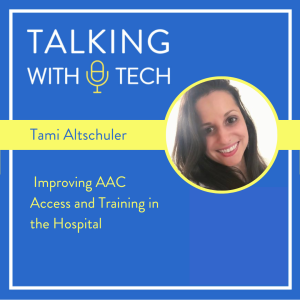
Thursday Sep 22, 2022
Thursday Sep 22, 2022
This week, Chris interviews Tami Altschuler, a medical-based SLP and graduate instructor who focuses on supporting AAC and communication in the hospital setting. She shares about her journey helping the doctors and nurses understand that communication is a medical necessity, and the patient and employee satisfaction improvements that have come from better supporting communication and AAC access for every patient that needs it.
Before the interview, Rachel and Chris discuss one of Rachel’s clients who has optical nerve damage that makes visual processing difficult. The family is concerned that he is not able to access his coursework and reading materials due to his visual difficulties. Rachel shares some of the assistive technology strategies she suggested, including voice typing in Google Docs, using Read & Write for Google Chrome, using text-to-voice using a camera, making text high contrast, and more!
Key ideas this week:
🔑 It was difficult to get initial buy in from physicians at her hospital to order SLP services for AAC and communication.Tami needs a doctor’s order to work with the patients - she can’t just work with a patient on her own initative. When Tami started at her hospital, the doctors didn’t know an SLP could help with a patient who can’t communicate (e.g. they are intubated).
🔑 SLPs in the medical setting often focus more on feeding and swallowing than on AAC and communication. It took a lot of working through “barriers to participation” (Beukelman & Mirenda (2013)) - i.e. resources, attitude, skill, and knowledge. Had to break through those barriers to help the other medical SLPs understand the need to support AAC.
🔑 The “Great Resignation” impacted the medical field in several ways, including the amount of knowledge nurses in Tami’s hospital have about AAC and communication. There was a mass exodus of pediatric nurses who had a lot of communication training, and the newer nurses were not as familiar. Tami’s hospital now has a process that trains nurses right away during new hire orientation about communication and AAC.
🔑 Writing a patient’s communication tools and strategies on the door outside the patient’s room can help the nurses know how a patient communicates before the enter the room.
You can reach Tami on Twitter @tami_altschuler
Visit talkingwithtech.org to access previous episodes, resources, and CEU credits that you can earn for listening to TWT episodes!
Help us develop new content and keep the podcast going strong! Support our podcast at patreon.com/talkingwithtech!
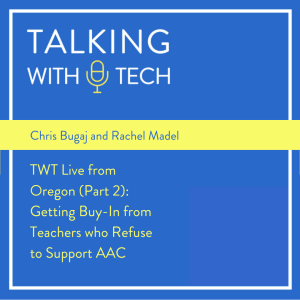
Thursday Sep 15, 2022
Thursday Sep 15, 2022
This week, we share Part 2 of TWT Live from Oregon! This week, Rachel and Chris talk with their audience about a range of topics, including getting buy in from teachers and staff and choosing which core words to start teaching!
Before the interview, Chris and Rachel answer a listener question, “Is putting a big poster with AAC symbols on the wall a good idea?” They point out the benefits of putting up AAC light-tech boards, and Chris describes why it is better to put up a poster of the kid’s core board than changing the symbols or moving them around.
Key ideas this week:
🔑 If an emergent communicator is struggling to learn how to use light-tech AAC, even with lots of modeling, you may want to try high-tech AAC. In some cases, using high-tech AAC can help him or her understand why and how we use AAC.
🔑 When dealing with a teacher or staff member who doesn’t want to use AAC, a “top down” approach that gets their administrator involved may cause push back in the long run and/or damage rapport. Try a “bottom up” approach first - ask probing questions to find out about that teacher’s challenges and point out where AAC can help (e.g. reducing difficult behaviors).
🔑 Celebrate the small wins for AAC users - if an emergent communicator make any progress towards independent communication, however small, make sure to celebrate and let everyone know! When someone makes a difference that impacts the life of another person, they are often inspired to do more!
Visit talkingwithtech.org to access previous episodes, resources, and CEU credits that you can earn for listening to TWT episodes!
Help us develop new content and keep the podcast going strong! Support our podcast at patreon.com/talkingwithtech!
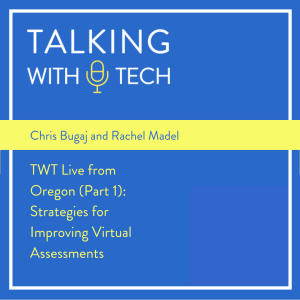
Wednesday Sep 07, 2022
Wednesday Sep 07, 2022
This week, we share Part 1 of a previously recorded Talking with Tech Live show with listeners from Oregon. This week, the listeners ask several questions related to conducting language and AAC assessments virtually, including how to make them more effective.
Before the interview, Chris and Rachel have a lively discussion about Gestalt Language Processing and how we can support AAC users who script. Rachel shares several ideas, including putting the student’s preferred scripts on their device as a way to make the device more interesting and motivating.
🔑 One tool that listeners suggested for virtual assessment is the Communication Matrix. https://communicationmatrix.org/ This assessment allows you to get input from caregivers through an online for. One benefit is it doesn’t require the chid to have to sit in front of a screen.
🔑 When we are trying to observe a person’s communication skills virtually, it may be better to have the caregivers video the student at hoome communicating in the ways they normally communicate. It can be difficult to truely observe a child during Zoom sessions - the child may not communicate the same way on Zoom because there is greater pressure to “perform.”
🔑 If we are considering a virtual assessment, it is important to consider training communication partners on how to optimize the virtual assessment. Is the student seated in their chair? What is the background noise situation? Preparing in this way can help the assessment go more smoothy.
Emily Quinn’s webinar on the Communication Matrix from Echo Voices https://drive.google.com/file/d/1-S-rVgOrozwa36mGxaW0ZQcNob2brWTx/view
Visit talkingwithtech.org to access previous episodes, resources, and CEU credits that you can earn for listening to TWT episodes!
Help us develop new content and keep the podcast going strong! Support our podcast at patreon.com/talkingwithtech!
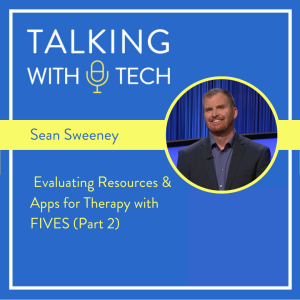
Wednesday Aug 31, 2022
Wednesday Aug 31, 2022
This week, we present Part 2 of Chris and Rachel’s interview with Sean Sweeney! Sean is a Speech-Language Pathologist and founder of SpeechTechie.com, a website that focuses on the intersection of speech therapy and technology. This week, he discusses his “FIVES” pneumonic to help evaluate if a resource (e.g. an app) is a worthwhile investment of time and money.
Before the interview, Chris and Rachel share about their recent trip to Montana to do a presentation, and some of the highlights of the trip. They also answer an excellent listener question that asks “Regarding the least-to-most prompting hierarchy, if the student is new to the board/device and we jump to the last step and model without expectation, how long do we stay at that level?”
Key ideas this week:
🔑 The least-to-most prompting hierarchy is related more to an individual words than to a particular student student. The amount of prompting that a student needs will depend on the word, so a student isn’t ever at a certain “level” of the hierarchy
for every word.
🔑 The symbols or pictures on an AAC system give users way to recognize the word(s) they want to say. Without the visual, it can be harder for students to construct an effective spontaneous utterance.
🔑 Sean came up who the pneumonic “FIVES” to help evaluate resources that he is considering using for therapy. FIVES stands for Fairly priced, Interactive (decision making, create narrative), Visual, Educationally relevant, and “Speechie” (i.e., the app can be used to target specific clinical objectives)
🔑 Sean likes to take materials and items from a student’s hobbies and use them to target his clinical objectives. For example, he has a student who loves Pokemon, so he pulls story grammar and vocabulary from a Pokemon comic to make the lesson more engaging and interactive.
Visit talkingwithtech.org to access previous episodes, resources, and CEU credits that you can earn for listening to TWT episodes!
Help us develop new content and keep the podcast going strong! Support our podcast at patreon.com/talkingwithtech!
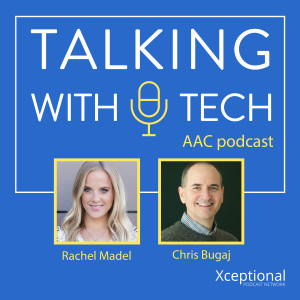
Wednesday Aug 24, 2022
Wednesday Aug 24, 2022
This week, we present Part 1 of Chris’s interview with Sean Sweeney! Sean is a Speech-Language Pathologist and founder of SpeechTechie.com, a website that focuses on the intersection of speech therapy and technology. In Part 1 of this interview, Sean discusses his recent appearance on the game show Jeopardy and some of the insider information he got as a contestant!
Before the interview, Chris and Rachel make some connections between Sean’s appearance on Jeopardy, including the similarities between the Jeopardy committee that decides if a question was answered correctly and the need for a team based approach to assessment. Chris and Rachel also chat about the difference between an “AAC app” and an “AAC system”.
Key ideas this week:
🔑 Giving a quiz that is put up on the board in front of a group of people (e.g. kahoot.com, baamboozle.com, quizizz.com) is as much a measure of reading ability and fluency as it is a measure of knowledge. Just like Jeopardy, you can read the question out loud to the contestants before giving them a chance to answer, giving slower readers a chance to succeed.
🔑 An “AAC system” is more than a particular app or tool. It is the combination of all the ways that a person communicates (e.g. low tech board, robust AAC app, and gestures) and often does not mean just one tool. There are circumstances (e.g. bath time) where a different tool, like a laminated core board, could be more effective than their primary app or tool.
🔑 It is common for people to not remember situations that required a lot of thinking, stress, and language analysis, such as going on a game show or giving a speech in public. This is, in part, because the brain is so focused on the immediate task that it isn’t committing things to memory in the way it normally would.
Visit talkingwithtech.org to access previous episodes, resources, and CEU credits that you can earn for listening to TWT episodes!
Help us develop new content and keep the podcast going strong! Support our podcast at patreon.com/talkingwithtech!
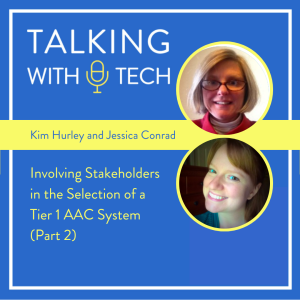
Wednesday Aug 17, 2022
Wednesday Aug 17, 2022
This week, we present Part 2 of Chris’s conversation with Kim Hurley and Jessica Conrad about the Specific Language System First Approach! Kim Hurley is an SLP and AAC Specialist who is considering moving her district to the Specific Language System First Approach. Jessica Conrad is an SLP and AAC Specialist who works for the Indiana PATINS project supporting AAC users and their circle of support. In Part 2, Chris, Kim, and Jessica continue to breakdown some of Kim and Jessica’s concerns with implementing the Specific Language System Approach, including failing to notice when a student needs a more individualized AAC system (i.e. a “Tier 3” AAC student), as well as and the need to include families in the process of selecting the “Tier 1/2” AAC system.
Before the interview, Chris and Rachel chat about Rachel’s recent visit to a Jack Johnson concert in Hawaii and the importance of Jack’s music to Rachel when she was battling seasonal depression (i.e., Seasonal Affective Disorder) as a young woman.
Key ideas this week:
🔑 One concern Kim had was that the “best” AAC system for younger students might not be as useful for middle or high school students. Chris pointed out that there are robust language systems, like TouchChat, that are appropriate for children all the way through adulthood, and that is something we can consider when selecting our Tier 1 system.
🔑 The earlier you can involve parents in the process of selecting AAC for their student, the better. This can mean involvement with overall selection of the Tier 1 AAC system, as well as involvement with the considerations meeting you hold to determine if the student should be given AAC.
🔑 If you make sure administrators, teachers, aides, and families are involved with the selection of your Tier 1 AAC system, then there will be better buy-in overall. Plus, it will help retain knowledge about the process and the Tier 1 AAC decision, even if the AAC Specialist (or another trained team member) leaves the district.
Visit talkingwithtech.org to access previous episodes, resources, and CEU credits that you can earn for listening to TWT episodes!
Help us develop new content and keep the podcast going strong! Support our podcast at patreon.com/talkingwithtech!

Wednesday Aug 10, 2022
Wednesday Aug 10, 2022
This week, we present Part 1 of Chris’s conversation with Kim Hurley and Jessica Conrad about the Specific Language System First Approach! Kim Hurley is an SLP and AAC Specialist who is considering moving her district to the Specific Language System First Approach. Jessica Conrad is an SLP and AAC Specialist who works for the Indiana PATINS project supporting AAC users and their circle of support. Chris, Kim, and Jessica explore some of Kim and Jessica’s concerns with moving towards a Specific Language System First Approach, and how those problems can be minimized or avoided.
Before the interview, Chris and Rachel chat about a recent visit to Arizona to teach a course on AAC and some of Chris’s previous encounters with Indiana’s PATINS project.
Key ideas this week:
🔑 One way to think about the Specific Language System First Approach is through Multi-Tiered Systems of Support. A Tier 1 support (i.e., support for almost everyone) would be the Specific Language System you give to almost everyone (e.g. a particular AAC app), while Tier 3 (individual support) would be for students that need a greater level of individual consideration for AAC (e.g. a student with CVI).
🔑 If you use the Specific Language System First Approach, it is important to remember that there will always be students who need individualized consideration (e.g. students with access issues). One idea is to train team members on the kinds of students that may not be well suited for Tier 1 and what to do if you think a Tier 3 support is needed.
🔑 When choosing the system that will become the Tier 1 support for most students, you can invite admins, teachers, and parents to participate in the discussion about the needs of students and some of the features that would be needed for students to be successful, as well as how those needs are met by particular AAC systems. This can help increase buy-in and lead to better understanding of the needs of teachers and students.
Visit talkingwithtech.org to access previous episodes, resources, and CEU credits that you can earn for listening to TWT episodes!
Help us develop new content and keep the podcast going strong! Support our podcast at patreon.com/talkingwithtech!
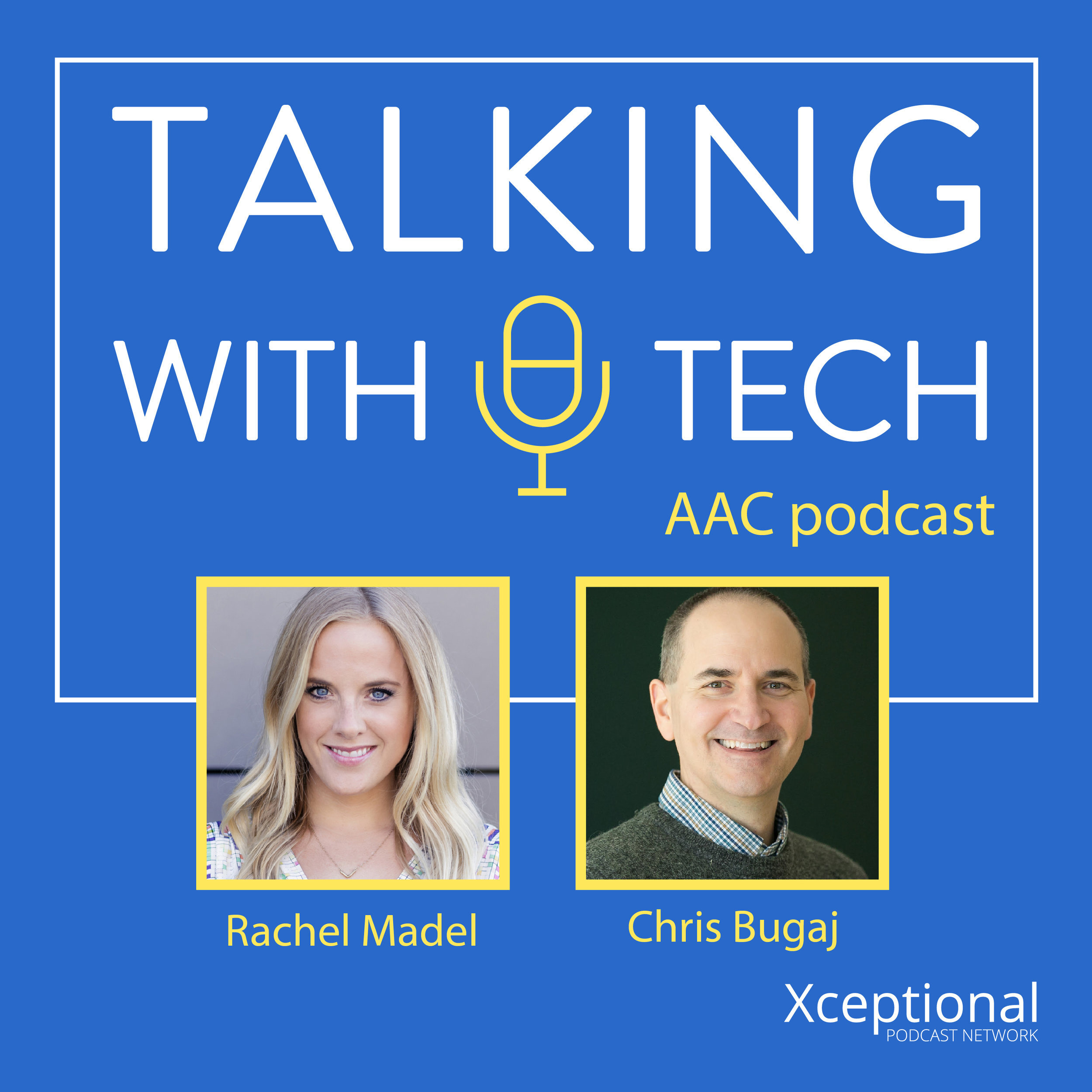
Join AAC experts Rachel Madel and Chris Bugaj as they dive into a weekly discussion about all things AAC (Augmentative and Alternative Communication). Every episode they deliver practical resources, clinical guidelines and relevant research to help clinicians better utilize technology for individuals with complex communication needs.
Episodes include interviews with industry thought-leaders, clinicians, parents, researchers and app developers to keep you on the pulse of the educational technology scene and better support communication through the use of technology.


